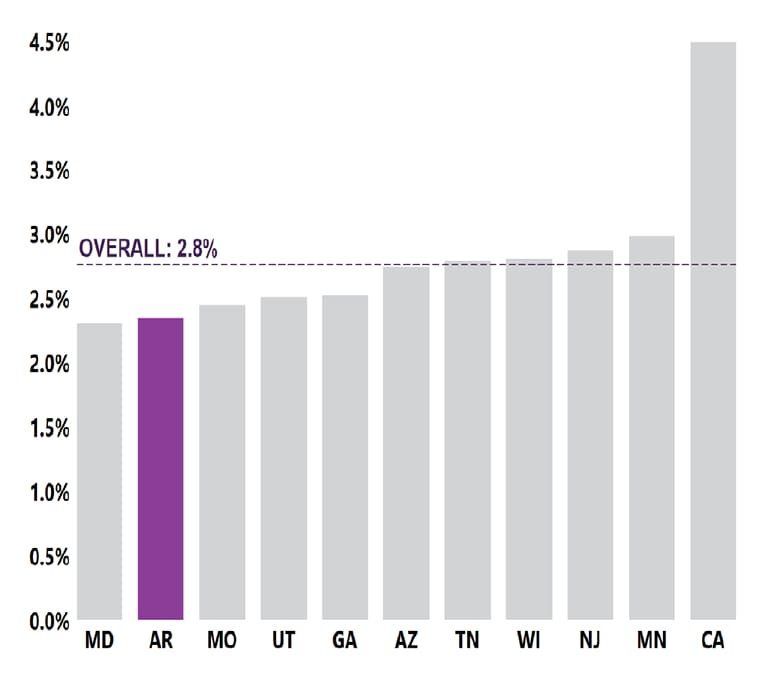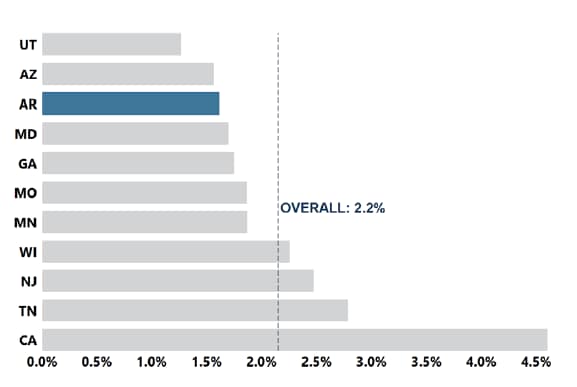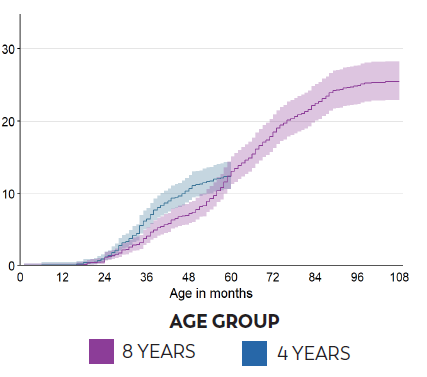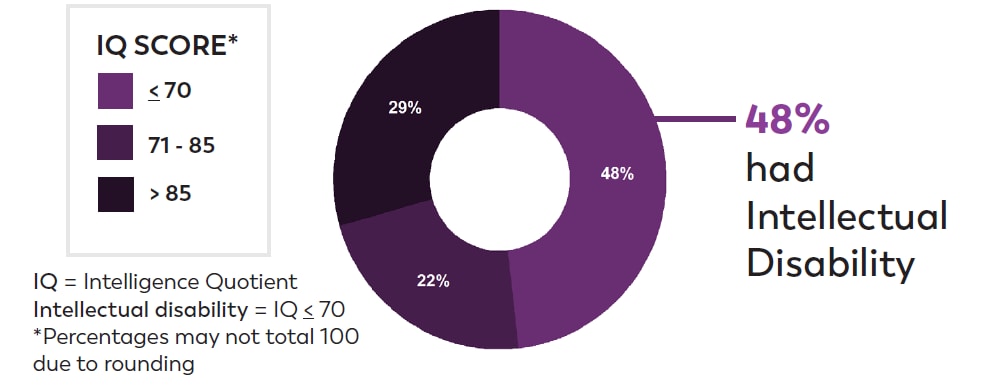A Snapshot of Autism Spectrum Disorder in Arkansas
‹View Table of Contents
Download and print this page [PDF – 207 KB, Print Only]
Findings from the Arkansas Autism and Developmental Disabilities Monitoring (AR-ADDM) Program help us to understand more about the number of children with autism spectrum disorder (ASD), the characteristics of those children, and the age at which they are first evaluated and diagnosed.

![]() SITE TRACKING AREA
SITE TRACKING AREA
Or 2.4% of 8-year-old children identified with ASD by AR-ADDM in 2020.

This percentage is slightly lower than the over-all percentage identified with ASD (2.8%) in all communities where CDC tracked ASD among 8-year-olds in 2020.
or 1.6% of 4-year-old children were identified with ASD by AR-ADDM in 2020.

This percentage is lower than the overall percentage identified with ASD (2.2%) in all communities where CDC tracked ASD among 4-year-olds in 2020
Children who were age 4 years were 1.8 times as likely to be identified with ASD by 48 months of age as children who were age 8 years.

IQ data available for 91%
Of 8-year-old children identified with ASD by AR-ADDM

Among 8-year-olds, Hispanic children were 1.4 times as likely and Asian/Pacific Islander (A/PI) children were 2.6 times as likely to be identified with ASD as White children.

Values indicate prevalence per 1,000 children. No significant differences in ASD prevalence were found between White and Black 8-year-olds.
Among 4-year-olds, Black children were 1.6 times as likely to be identified with ASD as White children.

About 88% of 4-year-old children identified with ASD received a comprehensive developmental evaluation by 3 years of age.

By 48 months
Children who were age 4 years were 1.8
times as likely to be identified with ASD
by 48 months of age as children who were
age 8 years.
What are the key take-away messages from Arkansas data?
- More children were identified with ASD in 2020 than in previous AR-ADDM and ADDM Network data.
- Children who were age 4 years in 2020 were more likely to be identified with ASD by 48 months of age than children who were age 8 years, indicating improvements in early identification of ASD.
How can this information be useful?
AR ADDM’s latest findings can be used to
- Promote early identification of ASD.
- Plan for ASD services and training.
- Guide ASD research.
- Inform policies promoting improved outcomes in health care and education for individuals with ASD.
Partners in Arkansas might consider different ways to continue to lower the age of first evaluation and diagnosis by community providers.
How and where was this information collected?
AR-ADDM uses a record review method. Specifically, this information is based on the analysis of data collected from the health and special education records of children who were 4 years old and 8 years old and living in one of 21 counties in central Arkansas in 2020.
8-year-old children in tracking area: 15,432
- 61% White
- 24% Black
- 9% Hispanic
- 1% Asian or Pacific Islander
- 4% American Indian or Alaska Native
4-year-old children in tracking area: 15,387
- 60% White
- 24% Black
- 10% Hispanic
- 1% Asian or Pacific Islander
- 5% American Indian or Alaska Native
What else does AR-ADDM do besides provide estimates of ASD?
AR-ADDM collaborates with the Arkansas Department of Health and investigators from the University of Arkansas for Medical Services (UAMS) to continue tracking the number and characteristics of 8-year-olds and 4-year-olds with ASD, as well as identifying characteristics of 16-year-olds with ASD.
In addition, AR-ADDM partners with UAMS Department of Pediatrics and Arkansas Children’s Hospital to provide training to physicians and staff using AR-ADDM’s individualized presentations on the number and characteristics of children with ASD. AR-ADDM also collaborates with the Arkansas Department of Education
to conduct analyses and present findings to Special Education staff across the state. AR-ADDM strives to work together with community partners to improve early identification and reduce disparities among children with ASD and other developmental disabilities.
“I’ve taught language difficulties and disorders to undergraduate and graduate students who are interested in speech language pathology. Autism Spectrum Disorder is one of the major areas I cover in class. I start my class with the ADDM report that provides reliable and valuable information on ASD and other developmental disabilities. As a clinician, professor, and researcher, I appreciate what ADDM has been doing for our community.”
SUNJUNG KIM THAO, Ph.D., CCC-SLP,
University of Central Arkansas Department of Communication Sciences and Disorders
Resources
FIRST CONNECTIONS
Services for children under 3 years with developmental delays or disabilities
1-800-643-8258 | dhs.arkansas.gov/dds/firstconnectionsweb/#fc-home
DEPT. OF EDUCATION’S SPECIAL EDUCATION UNIT
Special education services for school aged children with disabilities
1-800-482-8437 | https://dese.ade.arkansas.gov/Offices/special-education
ARKANSAS AUTISM RESOURCE AND OUTREACH CENTER
Support, education, and advocacy for families of individuals with ASD
1-800-342-2923 | aaroc.org
UAMS DENNIS DEVELOPMENTAL CENTER
Diagnostic and other services for children with developmental delays and disabilities
501-364-1830 | medicine.uams.edu/pediatrics/specialties/programs/dennis-developmental-center
ARKANSAS AUTISM PARTNERSHIP MEDICAID WAIVER PROGRAM
Provides intensive, evidence-based intervention for 20-30 hours/week in the homes of young children with autism who meet eligibility criteria
https://supports.org/programs/arkansas-autism-partnership/
HEALTHY CHILD CARE ARKANSAS
Training for child care providers in topics related to the overall well-being of children
www.healthychildcarear.org/
COMMUNITY-BASED AUTISM LIAISON AND TREATMENT (CoBALT) PROJECT
Comprehensive diagnostic assessments, early intervention services, and family support
https://www.cobaltar.org/about
CDC’S LEARN THE SIGNS. ACT EARLY.
Amanda Fender
Arkansas Act Early Ambassador
cdc.gov/ncbddd/actearly/ambassadors-list.html
CONNECT WITH AR-ADDM
Allison Hudson
Research Program Manager
University of Arkansas for Medical Sciences, Developmental Pediatrics – Little Rock, AR
aehudson@uams.edu
Pages in this Report
- 2023 Community Report on Autism
- Executive Summary
- Key Findings from the ADDM Network
- A Deeper Dive
- Spotlight On: Progress in Early Identification Disrupted during the COVID-19 Pandemic
- Spotlight On: A New Pattern in Racial and Ethnic Differences
- Data for Action
- ADDM Network Site Snapshots Overview
- A Snapshot of Autism Spectrum Disorder in Arizona
- ›A Snapshot of Autism Spectrum Disorder in Arkansas
- A Snapshot of Autism Spectrum Disorder in California
- A Snapshot of Autism Spectrum Disorder in Georgia
- A Snapshot of Autism Spectrum Disorder in Maryland
- A Snapshot of Autism Spectrum Disorder in Minnesota
- A Snapshot of Autism Spectrum Disorder in Missouri
- A Snapshot of Autism Spectrum Disorder in New Jersey
- A Snapshot of Autism Spectrum Disorder in Tennessee
- A Snapshot of Autism Spectrum Disorder in Utah
- A Snapshot of Autism Spectrum Disorder in Wisconsin
- Glossary
- References